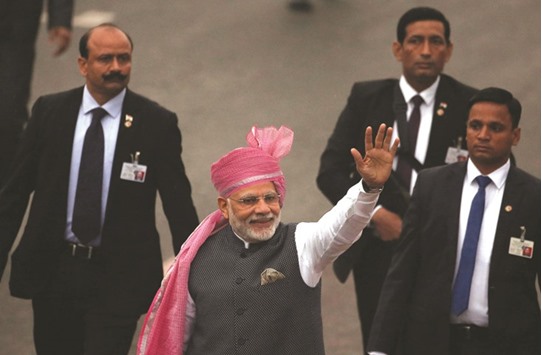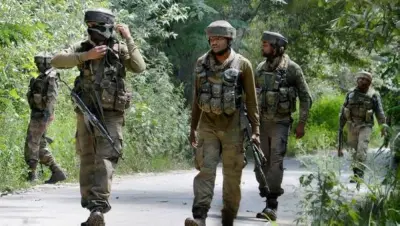A fleet of helicopters roars onto the dusty ground in Ghaziabad city, causing a wave of excitement in the crowd, as people clamber onto their seats for a better view of Indian Prime Minister Narendra Modi, who is here for an election campaign.
“Modi! Modi!” thousands chant in chorus, cheering and waving, as the 66-year-old leader blasts political rivals, in a throwback to his high-powered campaign during the 2014 national elections.
The rally is for a state election, but for Modi’s Bhartiya Janata Party (BJP) and India’s major political parties, the polls in Uttar Pradesh are about much more than that.
The polls have no bearing on whether Modi remains in office.
But elections in the country’s most populous state, with 204mn inhabitants, are a barometer of public opinion.
The results will shape national politics.
Listing his government’s achievements, Modi says the state election is about BJP’s battle against corruption and highlights the recent move to scrap high-denomination currency to fight tax fraud.
“When 2019 comes, Modi will be the first to give an account of all the work he’s done,” he said, referring to the next national elections, set for 2019, amid talk that the current poll is a referendum on his government.
Uttar Pradesh alone sends 80 lawmakers to India’s 543-member lower house of parliament.
In 2014, the BJP won a landslide tally of 71 seats, enabling it to clinch national polls.
Modi hopes to win a second term and his party’s performance in the bellwether state is a crucial test for the leader.
The vote could determine strategies for national elections and define the country’s political landscape, says Sanjay Kumar, director of the Delhi-based Centre for the Study of Developing Societies.
The BJP is locked in a tough fight with the incumbent Chief Minister Akhilesh Yadav from the regional Samajwadi Party, which has formed a political alliance with the country’s main opposition Congress Party, led by Rahul Gandhi, scion of the Nehru-Gandhi dynasty.
Bahujan Samaj Party, led by Mayawati, an icon for Dalits or lower-castes, is polling in third place.
“If BJP loses, it would be its second major defeat since the 2015 election in Bihar state, which will prove that forming smart alignments with regional parties to beat the BJP works.
This could be a template at the national level,” Kumar said.
If it wins, BJP would send a message that it is difficult to stop and add tremendous clout to its national presence.
Both Yadav and Gandhi, in their 40s, are projecting themselves as forces for youth and development.
The BJP has listed rising crime, corruption and unemployment as key issues while highlighting its pro-poor policies.
Although the Samajwadi Party has socialist origins, its support base is composed largely of farmers and cattle-breeders from the Yadav community and also from the Muslim community, which comprises 18% of the local population.
The Congress is trying to stay politically relevant, performing poorly in state elections ever since it was reduced to its lowest-ever tally in parliamentary polls.
It has joined hands with Samajwadi Party to ensure that the Muslim vote, critical to winning the election, is not split.
With nepotism and criminality rife in the mostly poor, rural state, elections here are invariably a raucous affair.
Caste and religion play a dominant role.
“Voting for your caste is as important as casting your vote,” said 26-year-old engineer Raj Maurya, pointing to allegations that Yadav filled positions in administration and police with members of his caste, angering other castes.
“We want to escape caste and associated discrimination, but it’s a vicious cycle. Indian politics is based on this truth. We will vote for leaders from our own caste, at least we will not suffer.”
The elections are also seen as a test for BJP after Modi’s controversial demonetisation move, which critics said have pushed the poor, farm workers and daily wage labourers into deeper distress.
But media surveys and interviews show that a majority of the poor support demonetisation, believing it an action against the corrupt.
“Demonetisation has not been much of an issue, even in other states like Punjab or Goa, which went to polls. In Uttar Pradesh, it is local issues like drinking water, roads and jobs that are important and these vary within regions,” Kumar said.
The balloting will be held in seven phases until March 8 and results will be announced on March 11, alongside tallies from four smaller states where elections are also being held.
Political analyst Satish Misra said the Uttar Pradesh elections could prove a hard task for BJP as its performance has failed to make a deep impression on the public and that many people may not vote for the party again.
K K Sharma, a Congress candidate from Ghaziabad, is confident that the combination of youth leaders will turn the tables.
“Uttar Pradesh will send a big signal to the country that parties can come together to defeat BJP. For BJP, the countdown to 2019 has begun,” he said.

Modi hopes to win a second term and his party’s performance in Uttar Pradesh is a crucial test for the prime minister.


